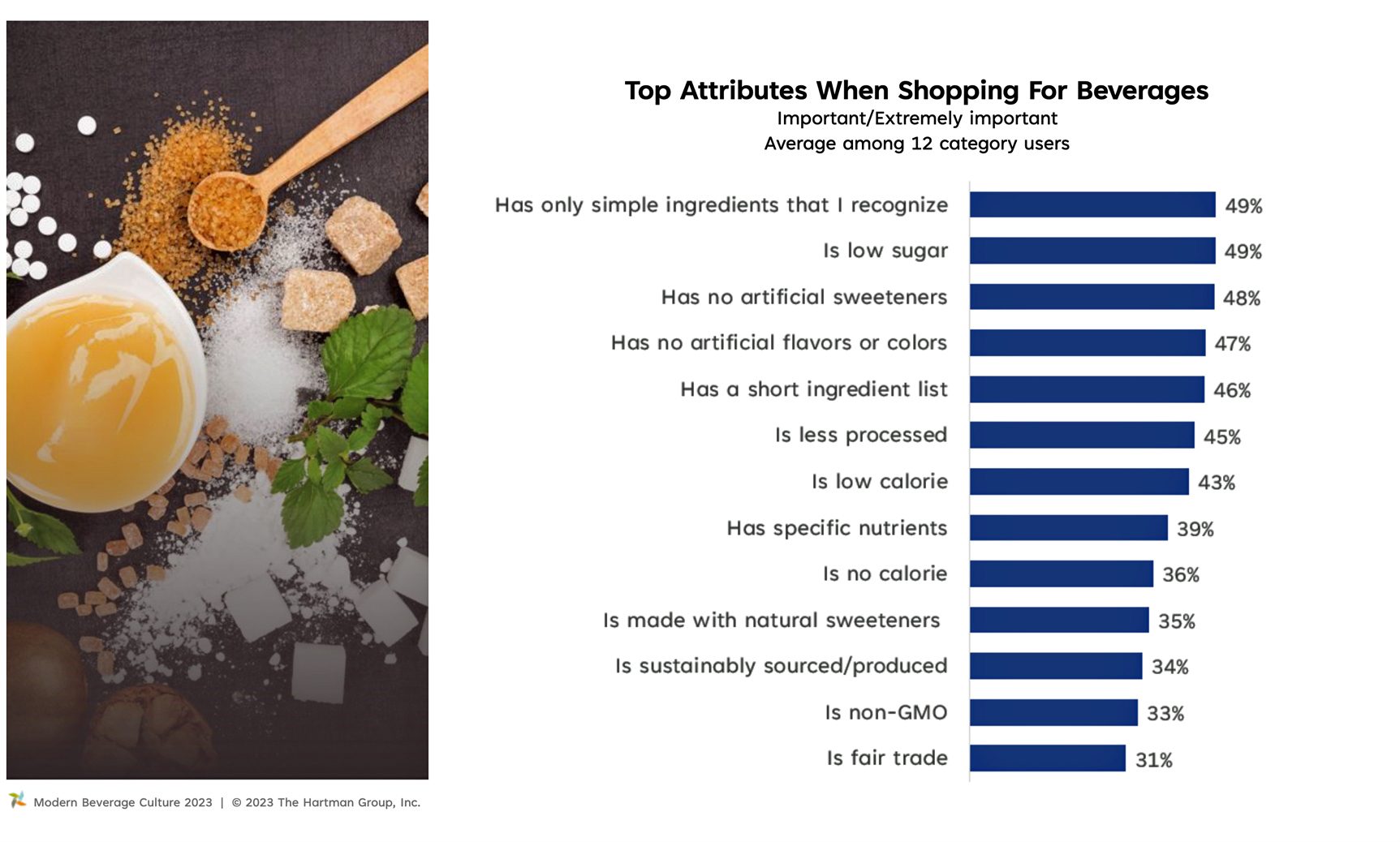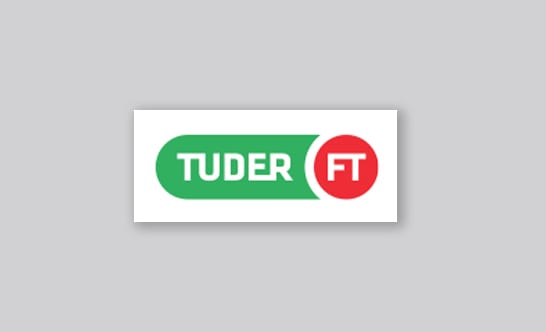Beverage Trends
A new report from The Hartmann Group, called the "Modern Beverage Culture 2023,” offers valuable insights on consumer preferences, and how simple ingredients are winning the day.
Gen Z and Older Millennials
Dictate Beverage Direction
There’s a reason why global beverage manufacturers offer so many choices: 71% of consumers always have a beverage with them. The growth in this category touches all demographic groups, and a common theme from a new Hartmann Group report, “Modern Beverage Culture 2023,” shows consumers want more nutrition and simple ingredients from their beverages.
The new report offers insights into generational preferences and prime consumer considerations in 2023. According to the report, these six drive the beverage market: taste, hydration, nutrition, experience, energy and pairing.
The Hartmann Group’s study found that consumers are purchasing three types of beverages:
● One to caffeinate/get energy
● One to hydrate (which includes nutrition)
● One for discovery
The report is based on a survey of 2,200 respondents in the spring of 2023 and covers a variety of beverage categories: alcohol, coffee, tea, dairy, dairy alternative, soda/soft drink, sports/energy drink, juice or smoothie, water/ functional or fermented, meal replacement, shakes, nutritional powders/drops, no/low alcohol. Ages range from 16 to 77, and the research included a week-long immersive qualitative research.
Image courtesy of Getty Images / ElenaVafina
by Grant Gerke

Canned cocktails are thriving due to portability, numerous use cases and, of course, taste. Image courtesy of Fishers Island
Simple Ingredients
Clean labeling has been a mainstay in the food and beverage segment for ten years now, and this report reinforces that simple ingredients and less artificial sweeteners trend. “We found that 50% of respondents are willing to pay more just to make sure that their beverages meet those quality standards—simple, low sugar and no artificial sweeteners—and that 35% are willing to pay more for beverages that use these sustainable practices,” says Melissa Abbott, VP of syndicated sales at The Hartmann Group during a recent webinar appearance.
For Gen Z and Millennials, according to the report, higher-quality ingredients and sustainable practices like B Corp or Fair Trade Practices translate into better-tasting drinks. “When we think about health and wellness, we see it as separate from sustainability,” says Abbott. “But the younger consumer, in particular, sees that when something is fair trade that it’s going to taste better and have higher-quality ingredients, which is something that's different from the older generations, particularly the boomer consumer.”
Below is the top five attributes when shopping for beverages:
● Simple Ingredients - 49%
● Low Sugar - 49%
● No Artificial Sweeteners - 48%
● No Artificial Flavors or Colors - 47%
● A Short Ingredient List - 46%

The report is based on a survey of 2,200 respondents and covers a variety of beverage categories: alcohol, coffee, tea, dairy, dairy alternative, soda/soft drink, sports/energy drink, juice or smoothie, water/ functional or fermented, meal replacement, shakes, nutritional powders/drops, no/low alcohol. Image courtesy of The Hartmann Group
The report also makes a strong case for how consumer choices for beverages are interconnected with these three pillars: Macro Trends, Needs States and Occasion Priorities, which skews toward pragmatic situations or preferences.
According to the report, the Needs States can be summed up as categories that compete for different benefits and occasions for beverages. The Needs States fall into five categories, including pairing, energy, experience, taste, hydration and nutrition. “You can be looking for more vitamin C, immunity or energy, and maybe it's a specific kind of energy, such as green tea,” says Abbott. “It's [green tea] going to help you think and focus.”
Abbott revealed how taste is still “king/queen” with consumers, but respondents are focused on hydration, which includes water and others. The research shows hydration beverage products can include water, sports products and energy drinks, but doesn’t necessarily exclude quenching thirst.
The report shows, “[I]t can be taste, nutrition or hydration, or a combination of these for consumers; it doesn’t have to be mutually exclusive.”

Besides reducing sugar intake, consumers are looking for alternative sweeteners in their beverages. Image courtesy of The Hartmann Group
The third pillar, Occasion Priorities, shows consumers will break from their assumed beverage category depending on the situation. “A consumer can be an energy drinks person, but can be open to different types of beverages based on the occasion rather than their actual demographic or psychographic background,” says Abbott. “So these Occasion Priorities reflect pragmatic considerations, and whether something is on sale, access and what you're seeking at that moment.”
Sustainability in Play
Besides nutrition and less sugar, consumers are convinced sustainable packaging is needed in their beverage choices. “Since our last beverage report, there's a significant share of consumers concerned about packaging and the health of the planet,” says Abbott. “Consumers want convenience, but can I recycle it? Will it actually even be recycled if I put it into a recycling bin?” The report also cites an increase in reusable cups, such as Stanley water bottles to reduce waste.
From the responses, packaging design also makes an emotional appeal to consumers’ values and identity: modular and easy-to-carry packages (cool), experiences and identifying consumer aspirations.
Where are these Beverages?
Similar to the fragmentation of news sources, it can be hard to find or even know about new beverages. So, how do consumers learn about new beverages and their sources of influence? The report shows these top five influencers in finding beverages (over-indexing indicates above-average preference in this category):
1. My Friends or Family - 38% (Over indexing - Gen Z)
2. Social Media (NET) - 28% (Over indexing - Gen Z and Millennials)
3. What is Available at the Store - 27% (Over indexing - Gen Z)
4. In-Store Advertising/Display - 19%
5. The Product Label - 17% (Gen Z)

Athletic Brewing’s design is clean and flirts with being a “real beer” in terms of the packaging. Image courtesy of Athletic Brewing
Besides finding products, Abbott also discussed new entrants to the segment. Specifically, no/low alcohol products are thriving due to clever branding like Athletic Brewing—no alcohol—and leveraging popular cocktail flavors in can packaging. Athletic Brewing’s design is clean and flirts with being a “real beer” in terms of the packaging. “There's been non-alcoholic beers out there, like O'Douls, but Athletic Brewing shows how to be cool,” says Abbott.
The report also touches on powders and mixes, and how these products are perceived and adopted by consumers.
For more information about the Modern Beverage Report 2023, visit The Hartmann Group site. FE


